Carl de Vogt played the leading role in the German silent drama Ahasver (Robert Reinert, 1917), a three-part film on the story of the Wandering Jew, a mythical immortal man whose legend began to spread in Europe in the 13th century. The original legend concerns a Jew who taunted Jesus on the way to the Crucifixion and was then cursed to walk the earth until the Second Coming. The exact nature of the wanderer's indiscretion varies in different versions of the tale. In this early film version Ahasver is condemned to bring misfortune.
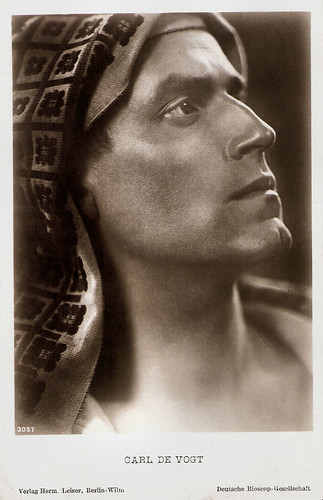
German postcard by Verlag Hermann Leiser, Berlin, no. 3057. Photo: Deutsche Bioscop-Gesellschaft. Publicity still of Carl de Vogt in Ahasver (Robert Reinert, 1917).
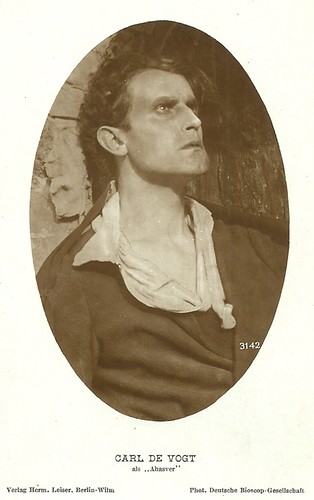
German postcard by Verlag Hermann Leiser, no 3142. Photo: Deutsche Bioscop-Gesellschaft (DBG). Carl de Vogt in Ahasver (Robert Reinert, 1917).

German postcard by Verlag Hermann Leiser, Berlin, no. 3143. Publicity still of Carl de Vogt in Ahasver (Robert Reinert, 1917).
In the first part of the trilogy, Ahasver, 1. Teil (1917), Ahasver reaches the gates of a castle on a journey through time in the year 1400 during a stormy night, but he is initially rejected by the farmers. While the storm rages outside, they take pity on him and bring Ahasver into the sheltered rooms.
There he begins to tell his story and why he is condemned to eternal restlessness. He describes how he is said to have cold-heartedly rejected the collapsing Jesus Christ in front of his home in Jerusalem. Ahasver later marries the daughter of the tenant, but brings, because of the curse on him, from now on only great misfortune about this family. And so he has to continue to move restlessly.
In the second part, Ahasver, 2. Teil - Die Tragödie der Eifersucht/The Tragedy of Jealousy (1917), Ahasver learns to know Count Gotheberg on his endless wanderings. Gotheberg is sentenced to death and and will be executed by means of a guillotine. Ahasver can save him from this bloody fate, but he develops erotic desires towards the count's beloved Eleonore. It comes as it has to come: the two men are in controversy over the coveted woman and in the fight the count dies.
In he third part, Ahasver, 3. Teil - Das Gespenst der Vergangenheit/The Spectre of the Past (1917), Ahasver becomes the director of a mine. He discovers a pretty young girl named Johanna in the ghetto, takes her with him and gives her to a junk dealer. Johanna grows up and falls in love with Ahasver's mining engineer Baumann. But Ahasver falls into the same sin: he desires the other one's woman. He seduces Johanna and ensures that his competitor Baumann dies.
Director-writer Robert Reinert shot Ahasver from May to June 1917 in the Bioscop studios of Neubabelsberg. The film sets were designed by Robert A. Dietrich and executed by Artur Günther. Hanns Lippmann was production manager.
The film was received well by the German critics. German film magazine Neue Kino-Rundschau: "All the advantages that we emphasised at the time of the huge film work Homunculus are also valid for this film... The performances are also excellent. Noteworthy is lead actor Carl de Vogt. Even his gloomy appearance seems to have been created for the role of the eternal Jew. He also knows how to express the terrible anguish of the restless."
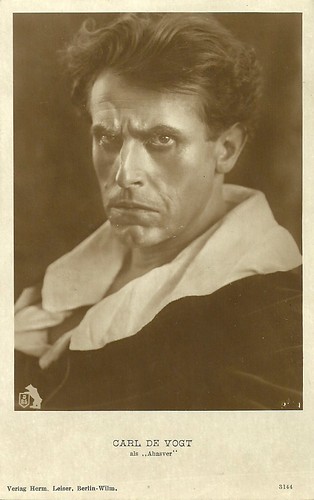
German postcard by Verlag Hermann Leiser, Berlin, no. 3144. Photo: Deutsche Bioscop-Gesellschaft (DBG). Carl de Vogt in Ahasver (Robert Reinert 1917).
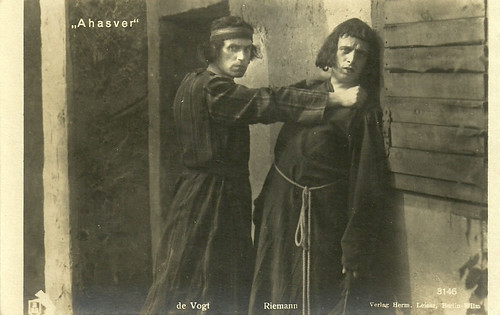
German postcard by Verlag Hermann Leiser, Berlin, no. 3146. Photo: Carl de Vogt and Johannes Riemann in Ahasver (Robert Reinert, 1917).
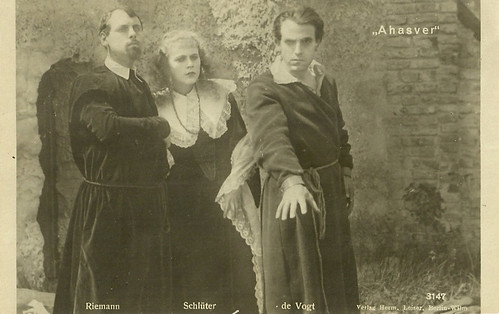
German postcard by Verlag Hermann Leiser, Berlin, no. 3147. Photo: Johannes Riemann, Dora Schlüter and Carl de Vogt in Ahasver (Robert Reinert, 1917).
Sources: Neue Kino-Rundschau (German), Filmportal.de (German), Wikipedia (German) and IMDb.

German postcard by Verlag Hermann Leiser, Berlin, no. 3057. Photo: Deutsche Bioscop-Gesellschaft. Publicity still of Carl de Vogt in Ahasver (Robert Reinert, 1917).

German postcard by Verlag Hermann Leiser, no 3142. Photo: Deutsche Bioscop-Gesellschaft (DBG). Carl de Vogt in Ahasver (Robert Reinert, 1917).

German postcard by Verlag Hermann Leiser, Berlin, no. 3143. Publicity still of Carl de Vogt in Ahasver (Robert Reinert, 1917).
The eternal Jew
In the first part of the trilogy, Ahasver, 1. Teil (1917), Ahasver reaches the gates of a castle on a journey through time in the year 1400 during a stormy night, but he is initially rejected by the farmers. While the storm rages outside, they take pity on him and bring Ahasver into the sheltered rooms.
There he begins to tell his story and why he is condemned to eternal restlessness. He describes how he is said to have cold-heartedly rejected the collapsing Jesus Christ in front of his home in Jerusalem. Ahasver later marries the daughter of the tenant, but brings, because of the curse on him, from now on only great misfortune about this family. And so he has to continue to move restlessly.
In the second part, Ahasver, 2. Teil - Die Tragödie der Eifersucht/The Tragedy of Jealousy (1917), Ahasver learns to know Count Gotheberg on his endless wanderings. Gotheberg is sentenced to death and and will be executed by means of a guillotine. Ahasver can save him from this bloody fate, but he develops erotic desires towards the count's beloved Eleonore. It comes as it has to come: the two men are in controversy over the coveted woman and in the fight the count dies.
In he third part, Ahasver, 3. Teil - Das Gespenst der Vergangenheit/The Spectre of the Past (1917), Ahasver becomes the director of a mine. He discovers a pretty young girl named Johanna in the ghetto, takes her with him and gives her to a junk dealer. Johanna grows up and falls in love with Ahasver's mining engineer Baumann. But Ahasver falls into the same sin: he desires the other one's woman. He seduces Johanna and ensures that his competitor Baumann dies.
Director-writer Robert Reinert shot Ahasver from May to June 1917 in the Bioscop studios of Neubabelsberg. The film sets were designed by Robert A. Dietrich and executed by Artur Günther. Hanns Lippmann was production manager.
The film was received well by the German critics. German film magazine Neue Kino-Rundschau: "All the advantages that we emphasised at the time of the huge film work Homunculus are also valid for this film... The performances are also excellent. Noteworthy is lead actor Carl de Vogt. Even his gloomy appearance seems to have been created for the role of the eternal Jew. He also knows how to express the terrible anguish of the restless."

German postcard by Verlag Hermann Leiser, Berlin, no. 3144. Photo: Deutsche Bioscop-Gesellschaft (DBG). Carl de Vogt in Ahasver (Robert Reinert 1917).

German postcard by Verlag Hermann Leiser, Berlin, no. 3146. Photo: Carl de Vogt and Johannes Riemann in Ahasver (Robert Reinert, 1917).

German postcard by Verlag Hermann Leiser, Berlin, no. 3147. Photo: Johannes Riemann, Dora Schlüter and Carl de Vogt in Ahasver (Robert Reinert, 1917).
Sources: Neue Kino-Rundschau (German), Filmportal.de (German), Wikipedia (German) and IMDb.
No comments:
Post a Comment